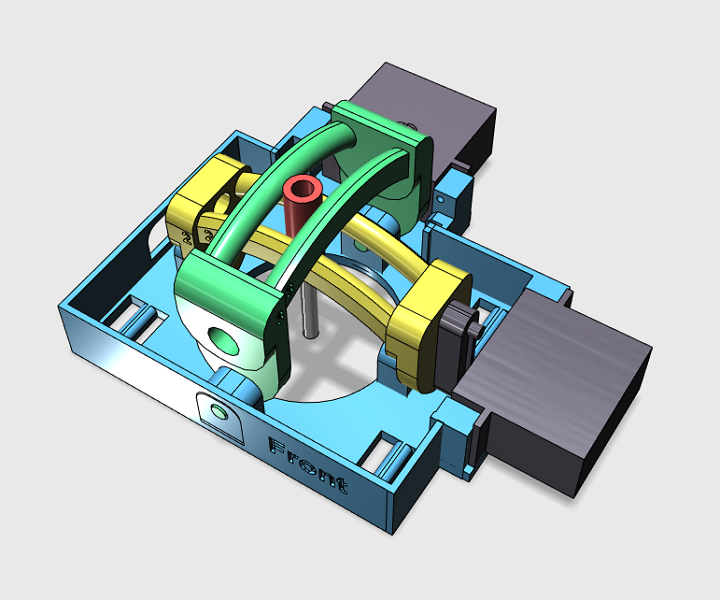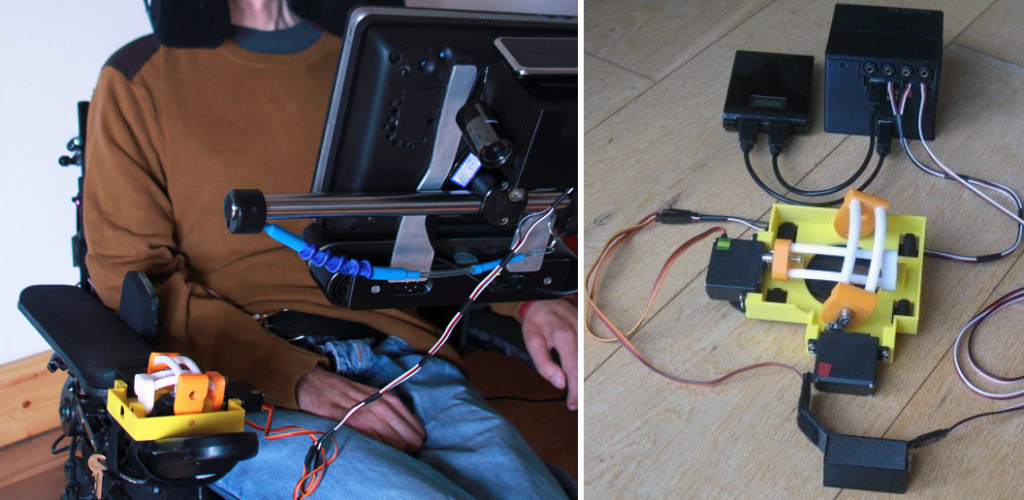Drive With Your Eyes: Eyedrivomatic 3D Printed Wheelchair Project a Brilliant Tool for ALS Sufferers
Patrick Joyce, Steve Evans, and David Hopkinson are all working on a project that will enable people who can no longer use their hands to operate their wheelchairs by eye movement, and they call it the Eyedrivomatic.
It will ultimately provide an inexpensive–and accessible–method for people with motorized wheelchairs to take complete control of their mobility needs, all via the movement of their eyes.
Joyce says the idea first came to him back in 2013, and it was at that time he took on the task of leading the project. And the importance of the project strikes very close to home for Joyce and Evans as they’re both forced to deal with the degenerative condition known as motor neuron disease, or ALS. While Joyce and Evans both use wheelchairs, and Joyce still has some movement available to him in this hands, Evans is now limited to eye movement and must rely on a caregiver to help him operate his chair.
“I can’t talk any more. I can make individual words understood, but it’s not what you would call talking. The only method I have left for controlling the computer, and what I now use for communicating, is a bluetooth wheelchair joystick, which works wirelessly as a mouse,” Joyce says of his current condition. “This method soon will no longer work as MND/ALS is weakening my hand relentlessly to the point of uselessness. I want to be in charge of my own life and remain as independent as possible for as long as possible, right until the end. And I am not alone. There are a multitude in my position and many more in a worse one.”
That’s critical to the pair as people with ALS have a tight and limited life expectancy. Most die within three years of diagnosis, but some live a little longer, and in a few rare cases, a lot longer. But the bottom line is that for most of those suffering from ALS, it’s just a matter of time until they only have use of their eyes to work with.
 With some 5,000 people diagnosed with ALS at any time in the UK, the number of people who would benefit from a way to independently operate their wheelchairs when they can only use their eyes to guide it is large, and as Evans has reached that point, he’s become the main ‘test driver’ for the system.
With some 5,000 people diagnosed with ALS at any time in the UK, the number of people who would benefit from a way to independently operate their wheelchairs when they can only use their eyes to guide it is large, and as Evans has reached that point, he’s become the main ‘test driver’ for the system.
Both Joyce and Evans have access to Eyegaze equipment, but the technology is only capable of operating a computer and not a wheelchair, or vice versa. Joyce says his goal was to make a device which could interface with the wheel chair mounted computer, and then physically move the wheelchair’s steering joystick.
But here’s the problem: it would mean forgoing modifications to the loaned hardware he had available, and it had to work with any wheelchair and Eyegaze technology combination.
After several months of design planning, Joyce settled on a two-part solution: an Electronic Hand unit, and a Brain Box to control it.
Though he had a design in mind, Joyce says the project was basically “dead in the water until the advent of accessible 3D printing.”
He ordered a 3D printer in 2014 to begin the process of prototyping the device, and as he waited for it to arrive, he sought the input of Tim Helps who already had access to a 3D printer and printed out Joyce’s design.
Once his printer arrived, Joyce built the second iteration of the Eyedrivomatic with the assistance of Tom Meeks and his team at 3D Systems.
By November, Joyce says he, Evans, and documentation specialist Hopkinson hope to have at least a handful of next-generation Eyedrivomatics in daily use by ALS sufferers, to have put a complete and detailed set of open source building documents available online and have a fully-manufactured model in production and in use worldwide.
“The system is complete and works, it can easily be put together without soldering by anyone – even an idiot – for less than £70, which is about one hundred of your American dollars,” Joyce says. “My idea is to make it open source and put the plans, software and instructions on the internet for anybody to use. There are thousands of people who would benefit from this, thousands of people who are stuck in the same place, immobile unless their (caregivers) move them.”
What do you think of this project by Patrick Joyce and Steve Evans, the Eyedrivomatic wheelchair steering system? You can let us know in the Eyedrivomatic forum thread on 3DPB.com. Check out more photos below of the Eyedrivomatic.
[Source: Hackaday]
Subscribe to Our Email Newsletter
Stay up-to-date on all the latest news from the 3D printing industry and receive information and offers from third party vendors.
You May Also Like
3D Printing News Unpeeled: A $3000 SLS System, Construction Subsidies and Parameters
The Housing Affordability Crisis is one of Canadian President Trudeau’s biggest issues. Now the government has made subsidies available, including scaling new technologies, 3D printed housing and libraries of reapproved...
“Bundled Light” Enables High Quality Plastic 3D Printing from LEAM
Naturally, we expect current 3D printing methods to continuously improve, but it continues to do so in the most surprising ways. The latest development comes from LEAM, a startup spun...
Each to Their Own: Exploring Creality’s Latest Ender Trio as the Company Strengthens Its Commitment to 3D Printing Advocacy
Creality has reaffirmed its commitment to promoting 3D printing. The launch of the Ender-3 V3 SE, Ender-3 V3 KE, and Ender-3 V3 showcases the company’s dedication to catering to diverse...
3D Printing News Briefs, March 23, 2024: AM in the US Coast Guard, Navy, & More
In today’s 3D Printing News Briefs, we’re discussing the use of 3D printing in various branches of the military, including the U.S. Coast Guard, the U.S. Navy, and the German...


































